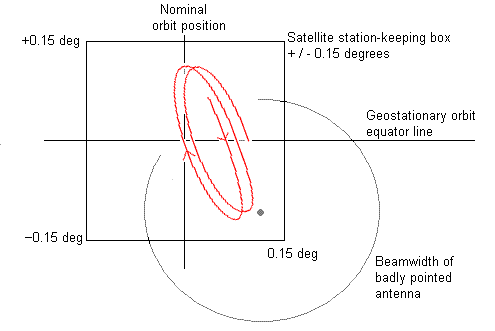Satellite station-keeping
Geostationary satellites are in orbit above the equator and go around the earth in the same direction as the earth rotates and at the same angular speed. They appear virtually stationary in the sky, so your satellite dish can see the satellite all of the time.
The satellites are not fixed to anything and float in space and their orbit is affected by small forces from the distant sun and also the earth's gravitational pull which is not perfectly spherical. Satellites have a supply of fuel allocated for station keeping and this fuel is used gradually over a planned lifetime period of 7 to 15 years to keep the satellite within typically +/- 0.15 deg east west and +/-0.15 deg north/south of its nominal orbit position.
North - South station keeping
The most significant effect is the pull of the sun which causes the inclination of the satellites orbit to increase at the rate of about 0.8 deg per year. If a satellite were left alone, after one year it would be going up and down daily in a north-south direction with an inclination amplitude of +/- 0.8 deg. This would cause the satellite to move well outside the beam-width pointing of virtually all, except the smallest, fixed pointing satellites dishes.
To keep a satellite's inclination down to a maximum of about 0.15 deg it is necessary to use fuel to fire its north/south thrusters every few weeks. About 90% of the station keeping fuel is allocated to correct this.
When initially positioned in orbit a satellite might have an inclination perhaps -0.5 degrees and this will be allowed to decrease to zero and increase to +0.15 deg before station-keeping fuel is used. Towards end of life north - south station keeping is abandoned and inclination is allowed to increase to say 4 degrees over a period 5 years while keeping the east west position within +/- 0.15 deg. This allows the satellite to be retained in use for tracking antennas.
East - West station keeping
The strength of the earth's gravitational field had three slight bumps around the equator with dips in between. This "triaxialty" causes satellites to drift slowly sideways towards where gravity pulls the most. This needs regular sideways thruster firings, just before the satellite is about to leave its station keeping box. Basically you give it a good kick back the other way and if you judge it just right it gradually goes across, stops just before it leaves the far side and then falls back sideways over the next few weeks, ready for the next thruster firing.

The diagram above shows the central horizontal equator line of the geostationary orbit with the nominal satellite [position and a 0.3 deg square size station keeping box. An example daily movement of the satellite is shown by the red line. Each loop cycle represents one day. The satellite crosses the equator twice a day. The shape of the curve is two sine waves plus sideways drifts and gradual increases or decreases in the amplitudes. Thruster firings have dramatic sudden effects and the smooth pattern restarts and needs to be relearned. Elliptical, near circular or figure of eight patterns are possible.
Superimposed on the above diagram is a dot which represents the pointing of an earth station dish antenna, with its beam width represented by the circle. As pointed, it will receive a good signal while the satellite is in the lower right corner of the square but service will fail for about 50% of the time when the satellite is in the upper left. This dish needs re-pointing about 0.1 deg up and 0.1 deg to the left so its beam width includes all of the satellites daily movement range. The best time to do this adjustment is when the satellite goes through the exact centre of the station keeping box. This may happen only once ever few weeks.
Important: Many small dish antenna will have a beam width larger than the station keeping box and all these dishes may be fixed.
Higher gain larger dishes with beam widths comparable to the size of the station keeping box require accurate alignment with the centre of the box.
Even higher gain antennas require active tracking systems that will typically make multiple measurements with small movements up/down/left/right every 15 minutes or so and work out what is best. Tracking systems are quite clever and can learn the satellite orbit to minimise motor wear and to keep the antenna on track during rain fades etc. Tracking does increase unreliability however, so fixed pointing with accurate alignment to the centre of the box should be considered for intermediate sized antennas. Poor tracking is often due to lack of skill and understanding in setting up the very many parameters for a tracking control system. Lubrication, back lash, step size, motor run time, stopping distances, angle calibration, mechanical and electrical non-linearity, volts per dB, are examples.
Narrow beam widths are the result or large diameter antennas, or high frequencies, or both. Use this antenna gain and beamwidth calculator to determine beamwidth for your dish size and frequency.
|
► Page created 2006, amended 6 May 2023, 21 Oct 2025. Satellite Signals Limited © 2005 all rights reserved. |